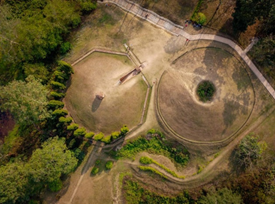

6th March 2023 (9 Topics)
Context
Assam’s pyramid-like structures known as moidams or maidams have met all the technical requirements of UNESCO’s World Heritage Centre.
- They were recently nominated for a Heritage site in Assam.
About the development:
- Charaideo in eastern Assam has more than 90 moidams, the mound-burial system of the Ahoms who ruled large swathes of the present-day State and beyond for some 600 years until the advent of the British in the 1820s.
- The nomination of Moidams – the Mound-Burial System of the Ahom Dynasty met all of the technical requirements outlined in the Operational Guidelines concerning the completeness check of nominations to the World Heritage List.
- The nomination of the Charaideo Moidams coincided with the 400th birth anniversary of Lachit Borphukan, the most celebrated Ahom general who thwarted the attempts of Mughal emperor Aurangzeb’s army to capture Assam.

|
The technical completeness of a nomination does not imply that the site concerned is of Outstanding Universal Value and would necessarily be inscribed on the World Heritage List. |

Charaideo: Significance
- Moidams (or Maidams) represent the late medieval (13th-19th century CE) mound-burial tradition of the Tai Ahoms in Assam, which lasted almost 600 years.
- Charaideo, more than 400 km east of Guwahati, was the first capital of the Ahom dynasty founded by Chao Lung Siu-Ka-Pha in 1253.
- Out of 386 Moidams explored so far, 90 royal burials at Charaideo are the best preserved, representative, and most complete examples of this tradition.
- The Charaideo Moidams enshrine the mortal remains of Ahom royalty along with the objects they cherished.
- But after the 18th century, the Ahom rulers adopted the Hindu method of cremation, later entombing the cremated bones and ashes in a Moidam at Charaideo.
The Ahom Dynasty:
- The Ahom dynasty (1228–1826) ruled the Ahom kingdom in present-day Assam, India for nearly 598 years.
- The dynasty was established by Sukaphaa, a Shan prince of Mong Mao who came to Assam after crossing the Patkai Mountains.
- The rule of this dynasty ended with the Burmese invasion of Assam.
- In external medieval chronicles, the kings of this dynasty were called Asam Raja, whereas the subjects of the kingdom called them Chaopha or Swargadeo.
- The Ahom rule lasted till the British annexed Assam in 1826, following the Treaty of Yandabo.
The famous battles of Ahoms:
Battle of Alaboi (1669):
- In 1669, Aurangzeb dispatched the Rajput Raja Ram Singh I to recapture territories won back by the Ahoms.
- The battle of Alaboi was fought between the Ahom armed force and Mughals trespassers on August 5, 1969, in the Alaboi Hills near Dadara in North Guwahati.
Battle of Saraighat (1671):
- The battle of Sarai Ghat was one of the most significant warfare in medieval India.
- The Battle of Saraighat was a naval battle fought between 1671between the Mughal Empire (led by the Kachwaha king, Raja Ram Singh), and the Ahom Kingdom (led by Lachit Borphukan) on the Brahmaputra river at Saraighat, Guwahati, Assam.
- Although weaker, the Ahom Army defeated the Mughal Army through brilliant uses of the terrain, clever diplomatic negotiations to buy time, guerrilla tactics, psychological warfare, military intelligence and by exploiting the sole weakness of the Mughal forces (navy).
- The Battle of Saraighat was the last battle in the last major attempt by the Mughals to extend their empire into Assam.
- Though the Mughals managed to regain Guwahati briefly later after a Borphukan deserted it, the Ahoms wrested control in the Battle of Itakhuli in 1682 and maintained it till the end of their rule.
|
UNESCO Heritage Site:
|
More Articles



